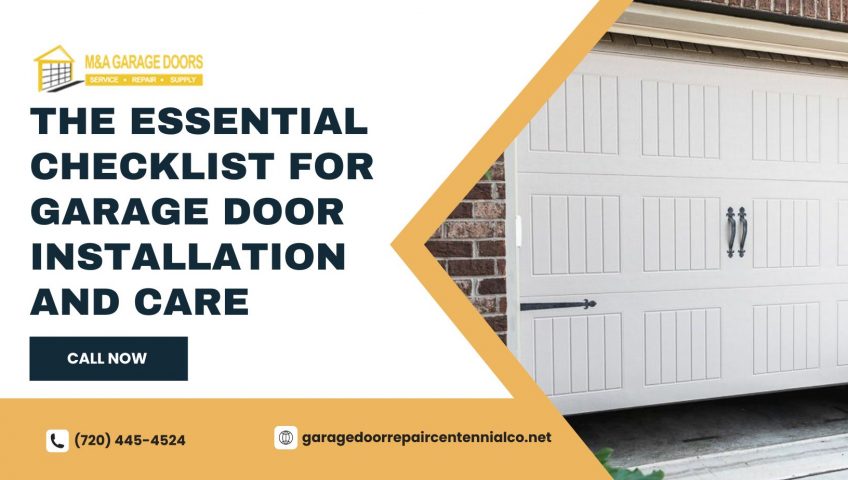Garage door installation may appear simple, but safety, efficiency, and longevity require many procedures. Good installation requires a rigorous checklist, whether you’re DIY or using a contractor. This detailed garage door installation guide covers all aspects and offers performance advice.
Prepare for Installation
Thorough preparation is essential before garage door installation. Measure the garage opening correctly to ensure the new door fits. Use tape to measure the opening’s width, height, and distance from walls and objects. Ensure the entrance is square and level to avoid installation and door operation issues.
Get all the installation equipment and materials next. The installation instructions list brackets, hinges, rollers, tracks, screws, bolts, nuts, and other hardware. Organizing and making things accessible will speed up installation.
Choose a Garage Door
Selecting the right garage door is vital to installation. Consider material, insulation, design, and budget. The most common garage door materials are steel, wood, aluminum, and composite. Each material has pros and cons for durability, upkeep, and attractiveness.
Matching your door to your home’s architecture and needs is vital. Garages attached to homes or used as workspaces need insulation. Insulated garage doors enhance energy efficiency and temperature regulation, especially in harsh regions.
Consider the door’s design, functioning (manual or automatic), and features like glass and decorative hardware. To ensure the garage door fits and provides enough clearance for automobiles and other equipment, measure the garage opening accurately.
Safety Measures
Safety is paramount during garage door installation. Read the installation handbook and follow safety instructions. This includes wearing safety glasses, gloves, and sturdy shoes.
When installing large garage door panels and tracks, avoid working alone. Ask a friend or family member to lift and hold components.
Turn off the garage electricity when using power tools or electrical components to avoid accidents. Install and wire the garage door opener according to manufacturer directions, then test the safety features before operating.
Correct Assembly and Installation
Follow the manufacturer’s instructions carefully throughout assembly and garage door installation to ensure alignment and performance. Assemble garage door panels, hinges, rollers, and tracks.
Install all components securely and per the manufacturer’s instructions. Focus on aligning tracks, installing hinges and rollers, and mounting the door opener to the ceiling or wall.
Avoid damage to components and the door by using the tools and hardware in the installation manual. Rushing might cause blunders and future troubles, so take your time installing.
Test and Adjust
Comprehensive testing is required after garage door installation to ensure the door’s performance. Open and close the door manually to check its equilibrium. Avoid binding or jerking. An imbalanced door might strain the opener and tracks, causing premature wear and failure.
Check the door opener’s auto-reverse option to make sure it handles impediments. Place a roll of paper towels in the door’s path and close it to test the auto-reverse capability. If the door doesn’t reverse after hitting the object, increase the opener’s sensitivity settings according to the manufacturer’s recommendations.
Insulation and weatherproofing
Weatherproofing and insulating your garage keep it energy efficient and waterproof. To keep drafts and moisture out, weather strip the garage door frame. This will lower garage heating and cooling costs and keep it comfortable.
Consider installing insulating panels or buying an insulated garage door to improve thermal efficiency. Insulation keeps garage occupants comfortable and protects stored things from severe heat or cold.
Install weather stripping and insulation securely to protect against the elements. To keep seals and insulation working, check for wear and replace them as needed.
Regular upkeep
Regular maintenance extends the life and functionality of your garage door. Check for frayed wires, worn rollers, and loose hardware regularly. Reduce friction and wear by lubricating hinges, rollers, and springs. If your garage door has any problem with the spring, you must hire a garage door spring repair service.
To keep tracks running smoothly, check for debris and clean them often. To avoid more complications, tighten loose nuts and screws and replace broken parts immediately.
It’s crucial to fix issues quickly in addition to routine maintenance. Minor flaws can grow and require costly repairs or replacements if ignored.
Conclusion
Setting up a garage door involves preparation, precision, and safety. Follow this detailed checklist to install, operate, and maintain your garage door for years. Doing garage door spring repair, installing, or hiring a contractor requires careful planning and execution. You may enjoy the convenience and security of a functional garage door for years by choosing the proper one, following safety requirements, and maintaining it.


Recent Comments